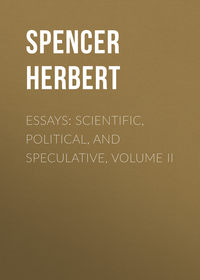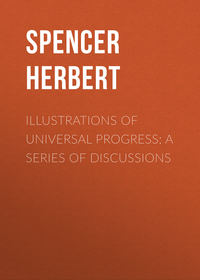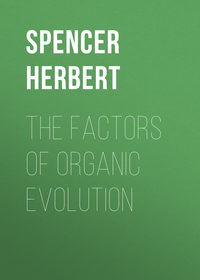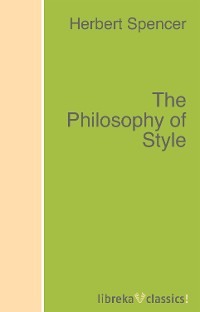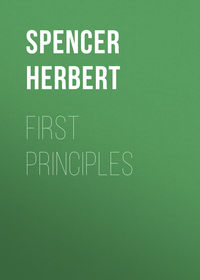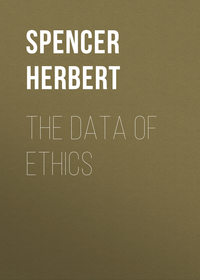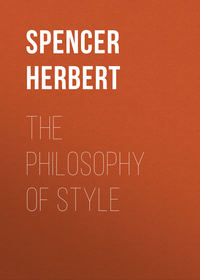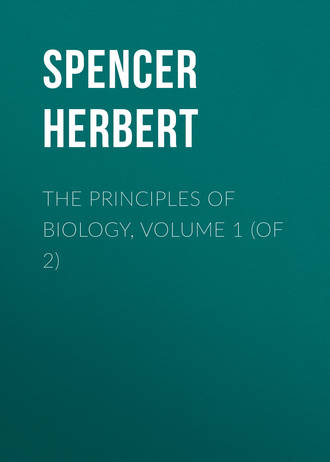 полная версия
полная версияThe Principles of Biology, Volume 1 (of 2)
But let growth be checked and development approach its completion – let the units of the aggregate be severally exposed to an almost constant distribution of forces; and they must begin to equilibrate themselves. Arranged, as they will gradually be, into comparatively stable attitudes in relation to one another, their mobility will diminish; and groups of them, partially or wholly detached, will no longer readily re-arrange themselves into the specific form. Agamogenesis will be no longer possible; or, if possible, will be no longer easy.
When we remember that the force which keeps the Earth in its orbit is the gravitation of each particle in the Earth towards every one of the group of particles existing 92,000,000 of miles off; we cannot reasonably doubt that each unit in an organism acts on all the other units, and is reacted on by them: not by gravitation only but chiefly by other energies. When, too, we learn that glass has its molecular constitution changed by light, and that substances so rigid and stable as metals have their atoms re-arranged by forces radiated in the dark from adjacent objects;41 we are obliged to conclude that the excessively-unstable units of which organisms are built, must be sensitive in a transcendant degree to all the forces pervading the organisms composed of them – must be tending ever to re-adjust, not only their relative attitudes but their molecular structures, into equilibrium with these forces. Hence, if aggregates of the same species are differently conditioned, and re-act differently on their component units, their component units will be rendered somewhat different; and they will become the more different the more widely the re-actions of the aggregates upon them differ, and the greater the number of generations through which these different re-actions of the aggregates upon them are continued.
If, then, unlikenesses of function among individuals of the same species, produce unlikenesses between the physiological units of one individual and those of another, it becomes comprehensible that when groups of units derived from two individuals are united, the group formed will be more unstable than either of the groups was before their union. The mixed units will be less able to resist those re-distributing forces which cause evolution; and may thus have restored to them the capacity for development which they had lost.
This view harmonizes with the conclusion, which we saw reason to draw, that fertilization does not depend on any intrinsic peculiarities of sperm-cells and germ-cells, but depends on their derivation from different individuals. It explains the facts that nearly-related individuals are less likely to have offspring than others, and that their offspring, when they have them, are frequently feeble. And it gives us a key to the converse fact that the crossing of varieties results in unusual vigour.
Bearing in mind that the slightly-different orders of physiological units which an organism inherits from its parents, are subject to the same set of forces, and that when the organism is fully developed this set of forces, becoming constant, tends slowly to re-mould the two orders of units into the same form; we see how it happens that self-fertilization becomes impossible in the higher organisms, while it remains possible in the lower organisms. In long-lived creatures which have tolerably-definite limits of growth, this assimilation of the somewhat-unlike physiological units is liable to go on to an appreciable extent; whereas in organisms which do not continuously subject their component units to constant forces, there will be much less of this assimilation. And where the assimilation is not considerable, the segregation of mixed units may cause the sperm-cells and germ-cells developed in the same individual, to be sufficiently different to produce, by their union, fertile germs; and several generations of self-fertilizing descendants may succeed one another, before the two orders of units have had their unlikenesses so far diminished that they will no longer do this. The same principles explain for us the variable results of union between nearly-related organisms. According to the contrasts among the physiological units they inherit from parents and ancestors; according to the unlike proportions of the contrasted units which they severally inherit; and according to the degrees of segregation of such units in different sperm-cells and germ-cells; it may happen that two kindred individuals will produce the ordinary number of offspring or will produce none; or will at one time be fertile and at another not; or will at one time have offspring of tolerable strength and at another time feeble offspring.
To the like causes are also ascribable the phenomena of Variation. These are unobtrusive while the tolerably-uniform conditions of a species maintain tolerable uniformity among the physiological units of its members; but they become obtrusive when differences of conditions, entailing considerable functional differences, have entailed decided differences among the physiological units, and when the different physiological units, differently mingled in every individual, come to be variously segregated and variously combined.
Did space permit, it might be shown that this hypothesis is a key to many further facts – to the fact that mixed races are comparatively plastic under new conditions; to the fact that pure races show predominant influences in the offspring when crossed with mixed races; to the fact that while mixed breeds are often of larger growth, pure breeds are the more hardy – have functions less-easily thrown out of balance. But without further argument it will, I think, be admitted that the power of this hypothesis to explain so many phenomena, and to bring under a common bond phenomena which seem so little allied, is strong evidence of its truth. And such evidence gains greatly in strength on observing that this hypothesis brings the facts of Genesis, Heredity, and Variation into harmony with first principles. We see that these plastic physiological units, which we find ourselves obliged to assume, are just such more integrated, more heterogeneous, more unstable, and more multiform molecules, as would result from continuance of the steps through which organic matter is reached. We see that the differentiations of them assumed to occur in differently-conditioned aggregates, and the equilibrations of them assumed to occur in aggregates which maintain constant conditions, are but corollaries from those universal principles implied by the persistence of force. We see that the maintenance of life in the successive generations of a species, becomes a consequence of the continual incidence of new forces on the species, to replace the forces that are ever being rhythmically equilibrated in the propagation of the species. And we thus see that these apparently-exceptional phenomena displayed in the multiplication of organic beings, fall into their places as results of the general laws of Evolution. We have, therefore, weighty reasons for entertaining the hypothesis which affords us this interpretation.
CHAPTER XA.
GENESIS, HEREDITY, AND VARIATIONCONCLUDED
§ 97a. Since the foregoing four chapters were written, thirty-four years ago, the topics with which they deal have been widely discussed and many views propounded. Ancient hypotheses have been abandoned, and other hypotheses, referring tacitly or avowedly to the cell-doctrine, have been set forth. Before proceeding it will be well to describe the chief among these.
Most if not all of them proceed on the assumption, shown in § 66 to be needful, that the structural characters of organisms are determined by the special natures of units which are intermediate between the chemical units and the morphological units – between the invisible molecules of proteid-substances and the visible tissue-components called cells.
Four years after the first edition of this volume was published, appeared Mr. Darwin's work, The Variation of Animals and Plants under Domestication; and in this he set forth his doctrine of Pangenesis. Referring to the doctrine of physiological units which the preceding chapters work out, he at first expressed a doubt whether his own was or was not the same, but finally concluded that it was different. He was right in so concluding. Throughout my argument the implication everywhere is that the physiological units are all of one kind; whereas Mr. Darwin regards his component units, or "gemmules," as being of innumerable unlike kinds. He supposes that every cell of every tissue gives off gemmules special to itself, and capable of developing into similar cells. We may here, in passing, note that this view implies a fundamental distinction between unicellular organisms and the component cells of multicellular organisms, which are otherwise homologous with them. For while in their essential structures, their essential internal changes, and their essential processes of division, the Protozoa and the component units of the Metazoa are alike, the doctrine of Pangenesis implies that though the units when separate do not give off invisible gemmules the grouped units do.
Much more recently have been enunciated the hypotheses of Prof. Weismann, differing from the foregoing hypotheses in two respects. In the first place it is assumed that the fragment of matter out of which each organism arises consists of two portions – one of them, the germ-plasm, reserved within the generative organ of the incipient individual, representing in its components the structure of the species, and gives origin to the germs of future individuals; and the other of them, similarly representative of the specific structure, giving origin to the rest of the body, or soma, but contains in its components none of those latent powers possessed by those of the germ-plasm. In the second place the germ-plasm, in common with the soma-plasm, consists of multitudinous kinds of units portioned out to originate the various organs. Of these there are groups, sub-groups, and sub-sub-groups. The largest of them, called "idants," are supposed each to contain a number of "ids"; within each id there are numerous "determinants"; and each determinant is made up of many "biophors" – the smallest elements possessing vitality. Passing over details, the essential assumption is that there exists a separate determinant for each part of the organism capable of independent variation; and Prof. Weismann infers that while there may be but one for the blood and but one for a considerable area of skin (as a stripe of the zebra) there must be a determinant for each scale on a butterfly's wing: the number on the four wings being over two hundred thousand. And then each cluster of biophors composing a determinant has to find its way to the place where there is to be formed the part it represents.
Here it is needless to specify the modifications of these hypotheses espoused by various biologists – all of them assuming that the structural traits of each species are expressed in certain units intermediate between morphological units and chemical units.
§ 97b. A true theory of heredity must be one which recognizes the relevant phenomena displayed by all classes of organism. We cannot assume two kinds of heredity, one for plants and another for animals. Hence a theory of heredity may be first tested by observing whether it is equally applicable to both kingdoms of living things. Genesis, heredity, and variation, as seen in plants, are simpler and more accessible than as seen in animals. Let us then note what these imply.
Already in § 77 I have illustrated the power which some plants possess of developing new individuals from mere fragments of leaves and even from detached scales. Striking as are the facts there instanced, they are scarcely more significant than some which are familiar. The formation of cauline buds, presently growing into shoots, shows us a kind of inheritance which a true theory must explain. As described by Kerner, such buds arise in Pimpernel, Toad-flax, etc., below the seed-leaves, even while yet there are no axils in which buds usually grow; and in many plants they arise from intermediate places on the stem: that is, without definite relations to pre-existing structures. How fortuitous is their origin is shown when a branch is induced to bud by keeping it wrapped round with a wet cloth. Even still better proved is the absence of any relation between cauline buds and normal germs by the frequent growth of them out of "callus" – the tissue which spreads over wounds and the cut ends of branches. It is not easy to reconcile these facts with Mr. Darwin's hypothesis of gemmules. We have to assume that where a cauline bud emerges there are present in due proportions gemmules of all the parts which will presently arise from it – leaves, stipules, bracts, petals, stamens, anthers, etc. We have to assume this though, at the time the bud originates, sundry of these organs, as the parts of flowers, do not exist on the plant or tree. And we have to assume that the gemmules of such parts are duly provided in a portion of adventitious callus, far away from the normal places of fructification. Moreover, the resulting shoot may or may not produce all the parts which the gemmules represent; and when, perhaps after years, flowers are produced on its side shoots, there must exist at each point the needful proportion of the required gemmules; though there have been no cells continually giving them off.
Still less does the hypothesis of Prof. Weismann harmonize with the evidence as plants display it. Plant-embryogeny yields no sign of separation between germ-plasm and soma-plasm; and, indeed, the absence of such separation is admitted. After instancing cases among certain of the lower animals, in which no differentiation of the two arises in the first generation resulting from a fertilized ovum, Prof. Weismann continues: —
"The same is true as regards the higher plants, in which the first shoot arising from the seed never contains germ-cells, or even cells which subsequently become differentiated into germ cells. In all these last-mentioned cases the germ-cells are not present in the first person arising by embryogeny as special cells, but are only formed in much later cell-generations from the offspring of certain cells of which this first person was composed." (Germ-Plasm, p. 185.)
How this admission consists with the general theory it is difficult to understand. The units of the soma-plasm are here recognized as having the same generative powers as the units of the germ-plasm. In so far as one organic kingdom and a considerable part of the other are concerned the doctrine is relinquished. Relinquishment is, indeed, necessitated even by the ordinary facts, and still more by the facts just instanced. Defence of it involves the assertion that where buds arise, normal or cauline, there exist in due proportion the various ids with their contained determinants – that these are diffused throughout the growing part of the soma; and this implies that the somatic tissue does not differ in generative power from the germ-plasm.
The hypothesis of physiological units, then, remains outstanding. For cauline buds imply that throughout the plant-tissue, where not unduly differentiated, the local physiological units have a power of arranging themselves into the structure of the species.
But this hypothesis, too, as it now stands, is inadequate. Under the form thus far given to it, it fails to explain some accompanying facts. For if the branch just instanced as producing a cauline bud be cut off and its end stuck in the ground, or if it be bent down and a portion of it covered with earth, there will grow from it rootlets and presently roots. The same portion of tissue which otherwise would have produced a shoot with all its appendages, constituting an individual, now produces only a special part of an individual.
§ 97c. Certain kindred facts of animal development may now be considered. Similar insufficiencies are disclosed.
The often-cited reproduction of a crab's lost claw or a lizard's tail, Mr. Darwin thought explicable by his hypothesis of diffused gemmules, representing all organs or their component cells. But though, after simple amputation, regrowth of the proximate part of the tail is conceivable as hence resulting, it is not easy to understand how the remoter part, the components of which are now absent from the organism, can arise afresh from gemmules no longer originated in due proportion. Prof. Weismann's hypothesis, again, implies that there must exist at the place of separation, a ready-provided supply of determinants, previously latent, able to reproduce the missing tail in all its details – nay, even to do this several times over: a strong supposition! The hypothesis of physiological units, as set forth in preceding chapters, appears less incompetent: reproduction of the lost part would seem to be a normal result of the proclivity towards the form of the entire organism. But now what are we to say when, instead of being cut off transversely, the tail is divided longitudinally and each half becomes a complete tail? What are we to say when, if these two tails are similarly dealt with, the halves again complete themselves; and so until as many as sixteen tails have been formed? Here the hypothesis of physiological units appears to fail utterly; for the tendency it implies is to complete the specific form, by reproducing a single tail only.
Various annulose animals display anomalies of development difficult to explain on any hypothesis. We have creatures like the fresh-water Nais which, though it has advanced structures, including a vascular system, branchiæ, and a nervous cord ending with cephalic ganglia, nevertheless shows us an ability like that of the Hydra to reproduce the whole from a small part: nearly forty pieces into which a Nais was cut having severally grown into complete animals. Again we have, in the order Polychætæ, types like Myrianida, in which by longitudinal budding a string of individuals, sometimes numbering even thirty, severally develop certain segments into heads, while increasing their segments in number. In yet other types there occurs not longitudinal gemmation only, but lateral gemmation: a segment will send out sideways a bud which presently becomes a complete worm. Once more, Syllis ramosa is a species in which the individual worms growing from lateral buds, while remaining attached to the parent, themselves give origin to buds; and so produce a branched aggregate of worms. How shall we explain the reparative and reproductive powers thus exemplified? It seems undeniable that each portion has an ability to produce, according to circumstances, the whole creature or a missing part of the creature. When we read of Sir J. Dalyell that he "cut a Dasychone into three pieces; the hindermost produced a head, the anterior piece developed an anus, and the middle portion formed both a head and a tail" we are not furnished with an explanation by the hypothesis of gemmules or by the hypothesis of determinants; for we cannot arbitrarily assume that wherever a missing organ has to be produced there exists the needful supply of gemmules or of determinants representing that organ. The hypothesis that physiological units have everywhere a proclivity towards the organic form of the species, appears more congruous with the facts; but even this does not cover the cases in which a new worm grows from a lateral bud. The tendency to complete the individual structure might be expected rather to restrain this breaking of the lines of complete structure.
Still less explicable in any way thus far proposed are certain remedial actions seen in animals. An example of them was furnished in § 67, where "false joints" were described – joints formed at places where the ends of a broken bone, failing to unite, remain moveable one upon the other. According to the character of the habitual motions there results a rudely formed hinge-joint or a ball-and-socket joint, either having the various constituent parts – periosteum, fibrous tissue, capsule, ligaments. Now Mr. Darwin's hypothesis, contemplating only normal structures, fails to account for this formation of an abnormal structure. Neither can we ascribe this local development to determinants: there were no appropriate ones in the germ-plasm, since no such structure was provided for. Nor does the hypothesis of physiological units, as presented in preceding chapters, yield an interpretation. These could have no other tendency than to restore the normal form of the limb, and might be expected to oppose the genesis of these new parts.
Thus we have to seek, if not another hypothesis, then some such qualification of an existing hypothesis as will harmonize it with various exceptional phenomena.
§ 97d. In Part II of the Principles of Sociology, published in 1876, will be found elaborated in detail that analogy between individual organization and social organization which was briefly sketched out in an essay on "The Social Organism" published in 1860. In §§ 241-3 a parallel is drawn between the developments of the sustaining systems of the two; and it is pointed out how, in the one case as in the other, the components – here organic units and there citizens – have their activities and arrangements mainly settled by local conditions. One leading example is that the parts constituting the alimentary canal, while jointly fitted to the nature of the food, are severally adapted to the successive stages at which the food arrives in its progress; and that in an analogous way the industries carried on by peoples forming different parts of a society, are primarily determined by the natures of things around – agriculture, pastoral and arable, special manufactures and minings, ship-building and fishing: the respective groups falling into fit combinations and becoming partially modified to suit their work. The implication is that while the organization of a society as a whole depends on the characters of its units, in such way that by some types of men despotisms are always evolved while by other types there are evolved forms of government partially free – forms which repeat themselves in colonies – there is, on the other hand, in every case a local power of developing appropriate structures. And it might have been pointed out that similarly in types of creatures not showing much consolidation, as the Annelida, many of the component divisions, largely independent in their vitalities, are but little affected in their structures by the entire aggregate.
My purpose at that time being the elucidation of sociological truths, it did not concern me to carry further the biological half of this comparison. Otherwise there might have been named the case in which a supernumerary finger, beginning to bud out, completes itself as a local organ with bones, muscles, skin, nail, etc., in defiance of central control: even repeating itself when cut off. There might also have been instanced the above-named formation of a false joint with its appurtenances. For the implication in both cases is that a local group of units, determined by circumstances towards a certain structure, coerces its individual units into that structure.
Now let us contemplate the essential fact in the analogy. The men in an Australian mining-camp, as M. Pierre Leroy Beaulieu points out, fall into Anglo-Saxon usages different from those which would characterize a French mining-camp. Emigrants to a far West settlement in America quickly establish post-office, bank, hotel, newspaper, and other urban institutions. We are thus shown that along with certain traits leading to a general type of social organization, there go traits which independently produce fit local organizations. Individuals are led into occupations and official posts, often quite new to them, by the wants of those around – are now influenced and now coerced into social arrangements which, as shown perhaps by gambling saloons, by shootings at sight, and by lynchings, are scarcely at all affected by the central government. Now the physiological units in each species appear to have a similar combination of capacities. Besides their general proclivity towards the specific organization, they show us abilities to organize themselves locally; and these abilities are in some cases displayed in defiance of the general control, as in the supernumerary finger or the false joint. Apparently each physiological unit, while having in a manner the whole organism as the structure which, along with the rest, it tends to form, has also an aptitude to take part in forming any local structure, and to assume its place in that structure under the influence of adjacent physiological units.




